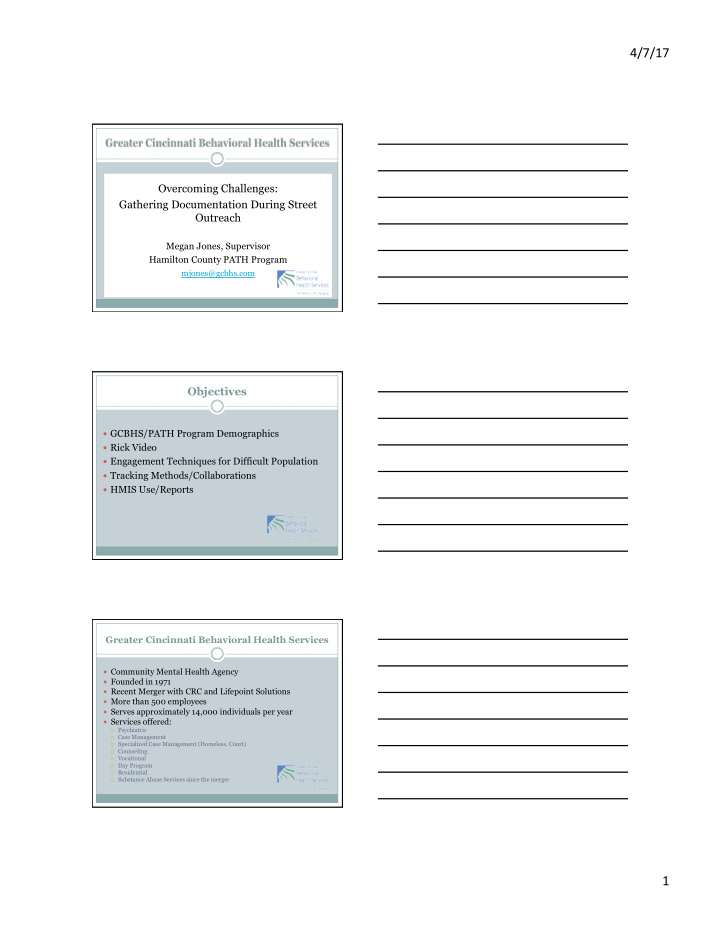



4/7/17 Overcoming Challenges: Gathering Documentation During Street Outreach Megan Jones, Supervisor Hamilton County PATH Program mjones@gcbhs.com Objectives GCBHS/PATH Program Demographics Rick Video Engagement Techniques for Difficult Population Tracking Methods/Collaborations HMIS Use/Reports Greater Cincinnati Behavioral Health Services Community Mental Health Agency Founded in 1971 Recent Merger with CRC and Lifepoint Solutions More than 500 employees Serves approximately 14,000 individuals per year Services offered: ¡ Psychiatric ¡ Case Management ¡ Specialized Case Management (Homeless, Court) ¡ Counseling ¡ Vocational ¡ Day Program ¡ Residential ¡ Substance Abuse Services since the merger 1
4/7/17 What is PATH? P rojects for A ssistance in T ransition from H omelessness Federal Program - Stewart B McKinney Act 1987 First and only major legislative • response to homelessness Focus on Homeless Outreach • The goal of PATH is to engage • homeless individuals who are mentally ill or dually diagnosed and connect them with mental health, substance abuse, housing, benefits, and other needed services Hamilton County PATH Program Eligible individuals are homeless, are believed to have a mental illness and are not in mental health services. PATH workers assist clients in scheduling and attending a mental health or substance abuse assessment and then getting to the intake at the assigned agency Hamilton County PATH Staff Mental Health Director PATH Team Supervisor 3 Outreach Workers Veteran Specialist Substances Specialist Peer Worker 2
4/7/17 Hamilton County PATH Data HMIS Homeless Documentation o Homeless Certificates/Finding Chronic Population 7858 Unduplicated Homeless Individuals in Shelters/ Streets (From PIT Count)—1229 living outside or place not meant for human habitation Over 58% of Homeless Individuals on the Street self report having Mental Illness Hamilton County PATH Data 73% Adults 27% Children 8% Unaccompanied youth 8% Adults with children Disproportionately African American (67%) Adult Males (44%) 1% Hispanic Population Largest age groups are 25-34 and 45-54 (36%) Rick’s Story 3
4/7/17 Engagement Techniques Engagement & Outreach Building relationships is critical with the homeless population Finding out what they see as their need/engagement tools Offering services and support based on their perceived needs Engagement Techniques Good Faith Assessments • Where have you been sleeping? • How long have you been there? • How did you get to be homeless? • Past Diagnosis, treatment, medications • Consider histories of trauma/perceptions of others • Visible Mental Health symptoms Interaction Tips Consider likelihood of SA and/or MI Consider histories: trauma/perception of authority Tell them your name/purpose and why you are out engaging with homeless population Leave safe distance/no sudden movements Do not contradict delusions/hallucinations 4
4/7/17 Interaction Tips Lead off with no-threatening topics/small talk Find out what is important to them Build relationship, casual approach…avoid technical language Homeless population will do things according to their own timeframes/priorities…BE FLEXIBLE!! Interaction Tips Appointments are challenging…especially if they are made a long time in advance Priorities and preferences are often not consistent with helping professionals’ priorities Roll with and/or redirect delusional material Back off if the conversation is not going well, shift to non-threatening topics Outreach Supplies Outreach supplies typically include socks, t- shirts, underwear, food, water, blankets, hygiene items and some clothing items 5
4/7/17 Outreach and Tracking Focus on building trust Be consistent/respectful Be flexible Attention to risk Outreach is: NOT TIME LIMITED Outreach and Tracking In groups for safety (especially going into camps) Daily at different times during the day In marked Outreach Van or Vehicle Wear identifiable clothing: hats, jackets, t-shirts, backpacks, etc Use of “Engagement Tools” Outreach and Tracking Track the homeless camps in the county for regular outreach Section the county in quadrants for tracking Monthly Outreach Calendar Quarterly Unofficial Homeless Counts Camp Lists Call In Logs 6
4/7/17 Collaborations Local Police/Sherriff’s Office/Jails ODOT Local Psychiatric Hospitals Shelters/Food Pantries Other area Outreach Programs CoC Workgroups Documentation/HMIS Collection of data from 1 st contact, unidentified (if necessary) Uses “un-duplication/record merge” as a person’s record is built. Implemented “Street Pop” to allow all street outreach programs to share data Use of “Homeless Certificate” to identify literally homeless population Documentation/HMIS Street homeless not auto-exited due to transient population Separate programs to identify literally homeless/at risk homeless Ability to record Alias, Street Name, or Nickname Update client record as relationship evolves 7
4/7/17 Questions 8
Recommend
More recommend